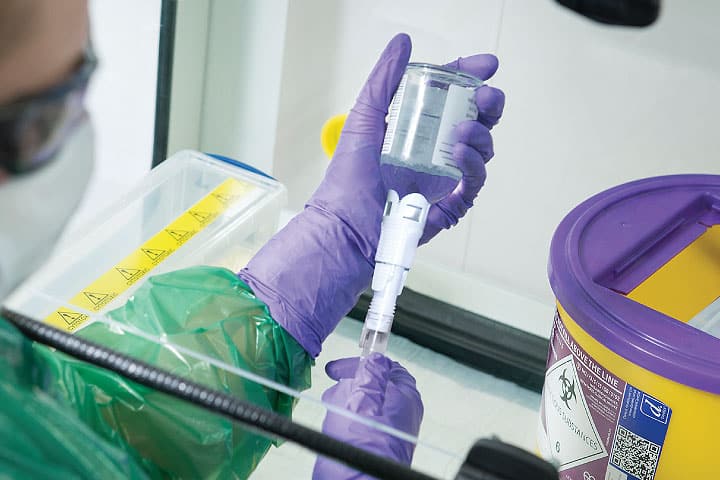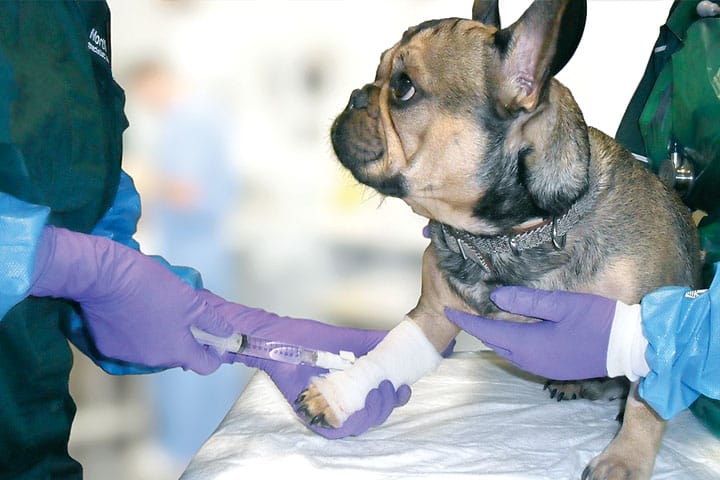
Chemotherapy is widely used in veterinary practice. 70.8% of respondents reported using cytotoxic chemotherapy for the treatment of cancer in one study. Yet, how many practices apply appropriate measures for handling cytotoxic drugs or the patients who receive them?
It is incumbent on all of us practicing chemotherapy to observe appropriate precautions to ensure minimal risk to all parties. That is fairly obvious. But, what are our individual responsibilities in law?
Employers:
Every owner of a business that uses substances hazardous to health, which of course, cytotoxic chemotherapy is, are legally required to have a written policy document defining how cytotoxic substances (hereafter known as chemo) are handled. This handling is not limited to the act of administration. It also includes ordering, receipt, storage, dispensing and disposal. There is also a requirement for statements relating to advice given to others outside the practice environment (owners) and even relating to reducing any possible impact of hazardous waste (excreta) on the environment.
It is enshrined in law that employers seek the input of their staff in the creation of this document and that the document can adapt to the changing needs of staff, the practice, the patients, the environment, etcetera. Advice should also be sought from appropriate experts, the BSAVA provide some guidance outlines on their website: https://www.bsava.com/Resources/Veterinary-resources/Medicines-Guide/Cytoxic-drugs.
Employees:
It isn’t all the bosses’ responsibility. All employees also have a legal duty to familiarise themselves with the aforementioned document and they have a duty to contribute to the creation and modification of policy.
So, clearly, everybody is involved.
Why do we care?
Chemo is toxic. It is poisonous to cells. Most susceptible are cells undergoing the process of cell division but it also damages DNA in non-replicating cells.
Chemo is…
- Mutagenic
- Teratogenic
- Carcinogenic
- Abortifacient
How much is too much?
Ideally, everybody apart from the patient should not come into contact with any chemo at all. The more exposure to chemo an individual receives, the greater their risk of problems such as pregnancy complications or chemo-induced cancer.
Where does exposure happen?
Contrary to popular belief, exposure rarely occurs through accidental needle-stick injuries. Most exposure comes from low-level exposure due to contamination of surfaces. It is crucial to be aware of all potential routes of exposure, from when the chemotherapy enters your practice to the moment when the animal you have given it to stops excreting the drug’s metabolites.
Advice to owners
It is important that owners are empowered to be able to minimise their contact with chemo excreted by their pet whilst being reassured that risks are low if the appropriate precautions are taken.
We hope that owners never come into contact with their pet’s faeces or urine, regardless of whether their pet is receiving chemotherapy. We therefore advise conventional methods of picking-up such as poo-bags, gloves or a shovel. Disposal can then follow normal methods. For faeces that cannot be picked up, or for urine on non-porous surfaces, copious irrigation is important (e.g. hosing the patio). For indoor accidents, should they ever occur, regular household chemical cleaning agents are perfectly satisfactory, especially bleach-based products, and gloves should be worn.
Practical tips
All chemotherapy
Ensure owners/staff have the confidence and competence to administer safely. This is absolutely essential. No staff member should be giving this medication without an understanding of the consequences of doing so.
Dispose of all waste as Hazardous Cytotoxic and Cytostatic Pharmaceutical Waste
Tablet chemotherapy
Always...
- Dispense in blister packs if possible
- Wear gloves to handle
- Administer whole
- Assume drug residue is present on the outside of tablets/capsules
Never…
- Manually divide tablets or capsules
Injectable chemotherapy
Always…
- Prepare and administer in designated low- traffic area
- Wear appropriate personal protective equipment
- Draw up using appropriate biological safety device(s)
- Use Luer Lok syringe/catheter connections
Never…
- Detach used chemotherapy syringe and needle/connectors
For intravenous (IV) injections/infusions
Always…
- Administer via secure intravenous catheter
- Use needle-free administration ports
- Draw up using appropriate biological safety device(s)
- Use Luer Lok syringe/catheter connections
Never…
- Detach used chemotherapy syringe and needle/connectors
Side effect management
The side effects of chemotherapy are largely familiar to all. Broadly speaking, they can be categorised into gastrointestinal and myelosuppressive signs.
Gastrointestinal signs tend to be the most prevalent and to have a greater impact on the perceived well-being of the patient. Side effect risk can be minimised through judicious stewardship of chemotherapy.
Use Specialist advice to ensure the best outcome for all potential chemotherapy candidates but in particular:
Patients with co-morbid conditions:
Think long and hard before giving chemotherapy to patients with:
- Kidney insufficiency
- Hepatic insufficiency
- Congestive or hypertrophic heart disease
It is very important to consider other medications
Certain drugs may either make the chemotherapy useless or increase the risk of side effects
- Cyclosporine
- Some parasiticide and anti-fungal treatments
- Many herbal supplements
Patients with elevated risk of intolerance of vinca alkaloids:
Seek advice before giving vinca drugs to:
- Border Collies, Rough Collies, Shetland Sheepdogs, Australian Sheepdogs
- Patients with severe GI disease
- Patients with hypoalbuminaemia
Patients with elevated risk of intolerance of anthracyclines:
Seek advice before giving doxorubicin to:
- Border Collies, Rough Collies, Shetland Sheepdogs, Australian Sheepdogs
- Dogs with any form of cardiac disease
- Cats with renal disease
Side effect prophylaxis
Vomiting risk may be reduced by prophylactic administration of maropitant. Its use for this purpose is licensed in dogs.
Diarrhoea, vomiting and listlessness severity, incidence of suspected infection and likelihood of hospitalisation are all reduced in dogs receiving prophylactic potentiated sulphonamide antibiotics alongside infusions of doxorubicin. However, prophylaxis candidates should be selected judiciously due to risk of antibiotic resistance and immune-mediated disease complications.
Ensure familiarity with cytotoxic products used. For agents which are used infrequently, seek to share care with an experienced Specialist in oncology.
Key messages
- Everyone involved in practicing chemotherapy must collaborate to ensure minimal risk to all parties
- Everyone involved in handling chemotherapy and patients receiving chemotherapy must have the confidence and competence to ensure safe administration of treatment and safe management of waste
- The practitioner must be familiar with specific chemotherapy risks before treatment is administered
- Specific co-morbidities that alter risk of treatment-associated side effects must be known before treatment is administered
Case Advice or Arranging a Referral
If you are a veterinary professional and would like to discuss a case with one of our team, or require pre-referral advice about a patient, please call 01883 741449. Alternatively, to refer a case, please use the online referral form
About The Discipline
Oncology

Need case advice or have any questions?
If you have any questions or would like advice on a case please call our dedicated vet line on 01883 741449 and ask to speak to one of our Oncology team.
Advice is freely available, even if the case cannot be referred.
Oncology Team
Our Oncology Team offer a caring, multi-disciplinary approach to all medical and surgical conditions.

